The Ongoing Impact of COVID-19 Policy in Education
It’s no stretch to say that the public policy
response to COVID-19 has changed and will continue to change
every aspect of education in K–12 and higher education for the
foreseeable future.
What once seemed a short-term emergency akin to “snow
days” has grown beyond most people’s wildest fears. Every state in
the nation shut down its K–12 schools last spring, and, with the
exception of one state (Montana), they all stayed closed through
the end of the school year. Colleges and universities closed one by
one. Some reopened only to have to close again weeks later.
We polled our readership to learn of the experiences taking
place across the nation and get a glimpse of what’s being planned
going into the spring 2021 semester and beyond. We heard from
facilities planners/managers, administrators, information technology
professionals, faculty, policymakers, architects, maintenance
professionals and engineers from around the country.
The impact on facilities planning, design and management
has been profound. “We were not prepared for anything like
this,” one K–12 education respondent told us. “We’re doing it all
on our own; every school is doing something different,” said another.
“The lack of guidance and support from the national level
is appalling.” One higher education respondent said, “[Campus]
will never fully reopen in the environment that we once knew.
COVID-19 has changed the very face of how instruction is given.”

Photo © Panchenko Vladimir
Delivering Instruction in the Fall
Overall, in both K–12 and higher education, the vast majority
of respondents reported that their institutions have been
using a hybrid model of instruction — about 70 percent in
K–12 education and 83.5 percent in higher education. All-online
instruction was the second-most-popular response, at
16.4 percent in K–12 and 12.6 percent in higher education.
In K–12, about 7 percent reported they were doing in-person
instruction, compared with less than 1 percent in higher education.
The remainder were doing variations — for example, mixed
by grade level or offering students the choice of either all online
or all in-person instruction. Some switched models partway
through the semester.
“We are primarily teaching online courses, no more than 25
percent face-to-face, and most of those we are offering an option
to participate via zoom,” said one respondent in the higher ed
space. “Most of our students have obeyed the rules of face masks
and social distancing. We’ve been having a rolling 14-day average
of between five and 14 infections, although we are relying
on self-reporting because we are not testing. Our IT department
has offered students resources for those with poor or no Internet
connections or who lack cameras on their home computers. We
are doing well.” (See Figures 1 and 2)
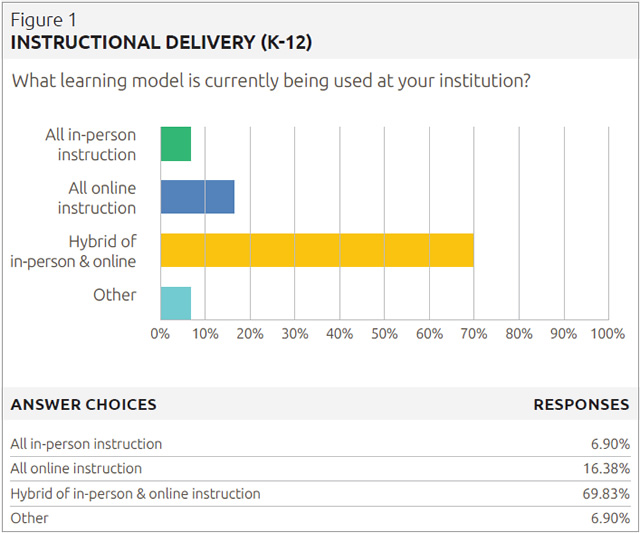
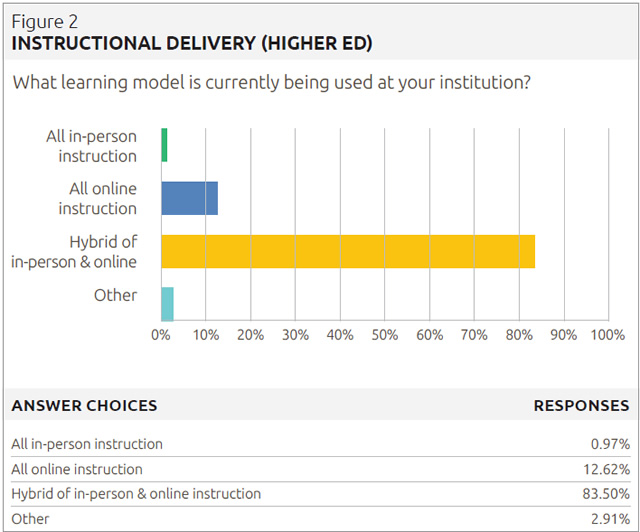
Remote Learning
Among those whose institutions are offering remote instruction, most rated the management
of that instruction positively. In K–12, more than 90 percent of respondents said
their institutions were doing fairly well, well or extremely well at handling remote instruction.
Just 6 percent said they were doing poorly. The remainder were either undecided or
deferential given the circumstances. One resspondent said their institution was doing “as
best as can be expected under crazy circumstances.”
In higher education, more than 94 percent said their institutions were doing fairly
well, well or extremely well. Just 4 percent said they were doing poorly. Another small
percentage reported mixed feelings. (See Figures 3 and 4)
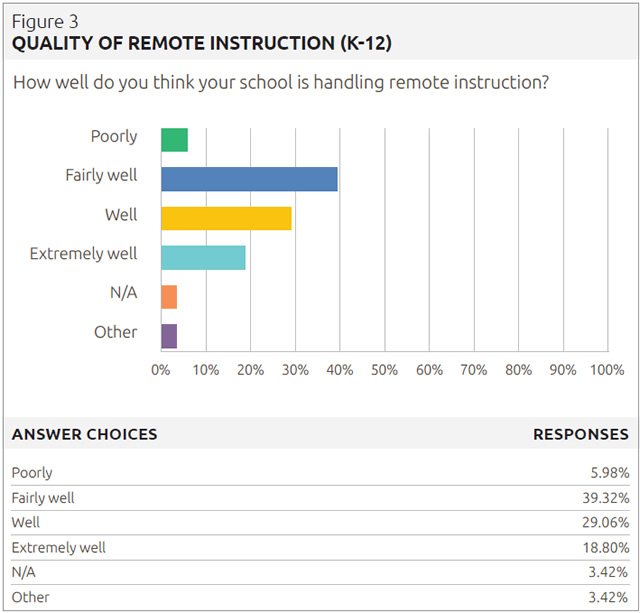
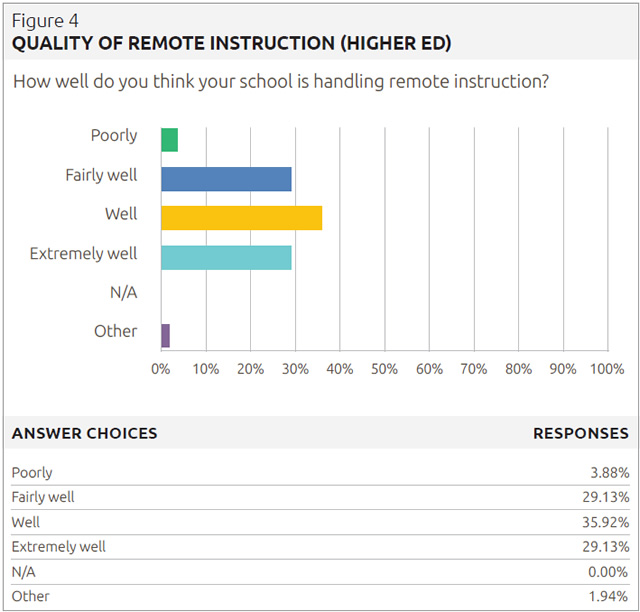
Facilities & Infrastructure
When it comes to facilities, most in K–12 and higher education said that their
existing facilities are adequate for delivering in-person instruction — 70 percent in
K–12 and nearly 80 percent in higher ed.
The biggest complaints about their
schools’ facilities among K–12 respondents
were:
- The size of the classrooms;
- The number of classrooms;
- Difficulty with social distancing;
- Difficulty cleaning or finding cleaning
products;
- Lack of technology resources;
- Busing; and
- Ventilation.
“The classroom is not big enough for
social distancing, and we do not have resources
for everyone to have all they need
without sharing,” according to one respondent
in K–12.
Some offered the caveat that, while facilities
are adequate now, they would not be
as more students begin attending in-person.
On the technology front, home internet
access is somewhat an issue for K–12, although
only 9.5 percent characterized it as
a major problem affecting a large percentage
of students. A third characterized it as
a moderate problem affecting a small but
substantial percentage of students. Most
(52 percent) said it was a minor problem
affecting a small percentage of students.
Six percent said it was no problem at all.
At the time of the survey (October/November 2020), 18 percent of K–12 respondents
reported that their institution
was forced to close at least once during
the fall semester owing to COVID-19 cases.
(See Figures 5 and 6)
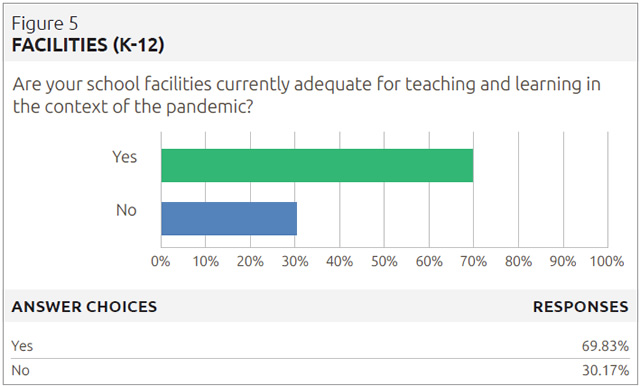
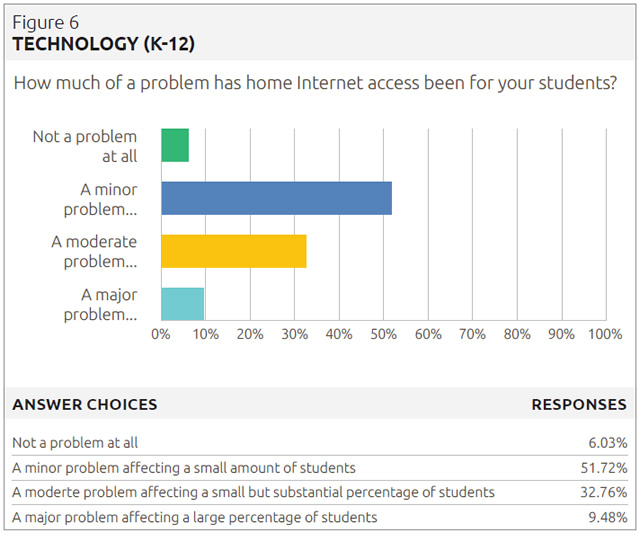
In higher education, where nearly 80 percent
of respondents said their facilities were
adequate, the most significant problems
among respondents were space and technology
infrastructure. Some, whose students
had not all returned to class at the time of
the survey, worried that facilities would be
inadequate but couldn’t be sure at the time.
As far as technology is concerned,
home internet access was even less of an issue
in higher ed than in K–12. More than
twice as many respondents (12.75 percent
in higher ed versus 6 percent in K–12) indicated
that home internet access was not
an issue at all. The majority (51 percent)
said it was a minor problem affecting few
students. About 27 percent said it was a
moderate problem affecting a small but
substantial percentage of students. And
nearly 9 percent said it was a major issue affecting a large percentage of students.
One respondent described their approach
to adapting existing facilities to
the needs of the pandemic: “We have
limited in person classes — mainly those
requiring hands-on instruction. We have
established procedures for cleaning between
classes and have scheduled breaks
between classes to allow additional cleaning.
We have deployed extensive hand
sanitizing and mask stations and have
marked public areas thoroughly for social
distancing.” (See Figures 7
and 8)
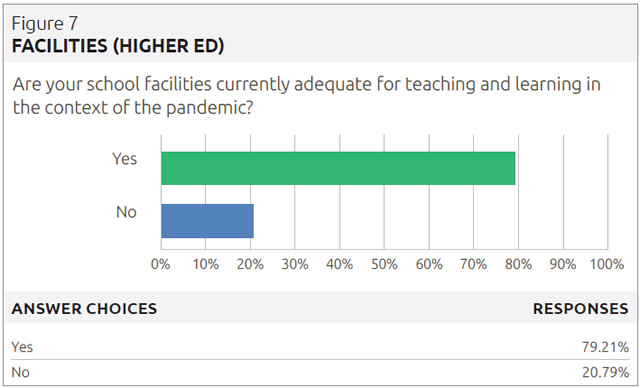
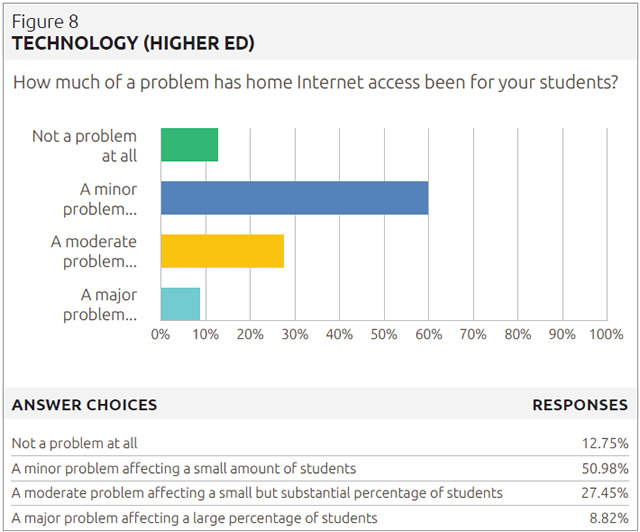
Takeaways, Lessons
Learned & Looking Forward
We asked our audience the following
open-ended question: “What has been the
biggest takeaway you’ve learned so far with
regard to school reopening?” Responses
to that question were, to say the least,
scattered all over the board. A few trends
emerged from their responses, however.
Among those who were strong on remote
learning prior to the pandemic, the
perception was that remote was working
well for students and would continue to
grow in the future. But among those who
were primarily face-to-face prior to the pandemic,
remote learning was perceived as a
poor substitute for in-person instruction.
There was widespread recognition of
the need for flexibility and patience.
Technology proved to be a huge help
to education professionals, although many
reported that they needed more access to
technology tools. In fact, when asked what
were the most helpful tools used this fall
semester, digital tools were by far the most
frequently lauded. Among the most frequently
cited helpful tools were:
- Zoom;
- Google Classroom;
- Microsoft Teams;
- Learning management systems such as
Blackboard and Canvas;
- Laptops and Chromebooks;
- WebEx; and
- Screencastify.
Of non-digital tools, general cleaning
products, masks and electrostatic sprayers
were most frequently cited.
Looking ahead to procedures for the spring, in both K–12 and higher education,
respondents generally agreed that
there will be a continued emphasis on
online learning, continued social distancing
and ongoing rigorous cleaning procedures.
By far, however, the most popular response
to the question of what new procedures
will be implemented in spring was
“not sure.”
When asked what the most significant
challenges schools, colleges and
universities still face, the most common
responses across both K–12 and higher
ed were:
- Shortage of teachers and staff;
- Class size;
- The inadequacy of remote learning versus
face-to-face;
- Adherence to safety procedures, such as
wearing masks continually and maintaining
physical distance;
- Student disengagement with two commonly
cited causes: the remote learning environment and, in
the case of in-person instruction, the wearing of masks;
- Lack of funding; and
- Lack of leadership.
Several survey participants lamented the challenges of overwork
and mental and physical strain in these circumstances. “Educators
have put everything on the line,” one K-12 respondent
said. “Our families, our mental and physical health ... have all
been impacted. Many of us are so exhausted, beaten down and
frustrated that we will leave the profession prematurely.”
Equitable access to technology was also widely cited as a
major challenge by several respondents. “We wouldn’t be comfortable
teaching in school if one child is left in the hallway and
can’t access the class, but when we go virtual there doesn’t seem
to be the same urgency when students are locked out of classes
due to lack of devices or not having the wherewithal to use the
devices they have,” one K-12 respondent noted.
The keys to success this spring? According to many: budgeting
for additional technology, providing internet access for
those who need it and providing training to faculty and staff in
the technologies they need to deliver instruction in remote and
hybrid learning environments.
Methodology
The survey was conducted among Spaces4Learning readers
online over a three-week period in late October through early
November. Two-hundred twenty-two surveys were completed —
104 from higher education, 118 from K–12.
This article originally appeared in the Fall 2020 issue of Spaces4Learning.